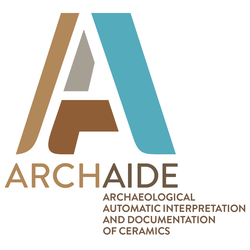ARCHAIDE Portal for Publications and Outputs
ArchAIDE consortium, 2019. https://doi.org/10.5284/1050896. How to cite using this DOI
Data copyright © ArchAIDE consortium unless otherwise stated
This work is licensed under a Creative Commons Attribution 4.0 International License.

Primary contact
Gabriele
Gattiglia
Senior researcher
Universita di Pisa
Dipartimento di Civilta e Forme del Sapere
Via Trieste 40
Pisa
56126
Tel: +39 050 2215228
Resource identifiers
- ADS Collection: 3369
- DOI:https://doi.org/10.5284/1050896
- How to cite using this DOI
Introduction
ArchAIDE is a European Union Horizon 2020 research and innovation programme which aims to create a new system for the automatic recognition of archaeological pottery from excavations around the world.
The archaeological partners of the consortium are the MAPPA Lab at the University of Pisa (coordinator) which has a relevant experience in mathematical and digital application in Archaeology, and archaeological communication; the Material Culture and Archaeometry research unit at the University of Barcelona, which is focused on promoting studies of material culture, especially on archaeological ceramics, and archaeometric approaches; the Digital Archaeology Laboratory at the University of Cologne, which manages ARACHNE, a highly structured object database in partnership with the German Archaeological Institute (DAI); and the Archaeology Data Service (ADS) at the University of York, which is the world-leading digital data archive for archaeology. The consortium involves also two private companies carrying out preventive and development-led archaeological investigations: Baraka Arqueólogos S.L., which is experienced in the study of archaeological ceramics, and Elements S.L which is experienced in the application of digital technologies related to ceramic studies. Finally, the consortium’s technical ICT partners are the Visual Computing Lab at CNR-ISTI, an institute of Italian CNR devoted to research on Visual Media and Cultural Heritage; the School of Computer Science at Tel Aviv University, which is ranked 20th in the Shanghai ranking of all Computer Science departments in the world; and the private software company, Inera s.r.l, which has experience in the field of protocols and web apps.
Every day, archaeologists from around the world are working to discover and tell stories around objects from the past, investing considerable time, effort and funding to identify and characterise individual finds. Pottery is of fundamental importance for the comprehension and dating of archaeological contexts, and for understanding the dynamics of production, trade flows, and social interactions. Today, this characterisation and classification of ceramics is carried out manually, through the expertise of specialists and the use of analogue catalogues held in archives and libraries. The goal of ArchAIDE is to optimise and economise this process, making knowledge accessible wherever archaeologists are working.
ArchAIDE will support the classification and interpretation work of archaeologists (during both fieldwork and post-excavation analysis) with an innovative app designed for tablets and smartphones, designed to be an essential tool for archaeologists. Ceramic fragments will be photographed, their characteristics sent to a comparative collection, which activates the automatic object recognition system, resulting in a response with all relevant information linked, and ultimately stored, within a database that allows each new discovery to be shared online.
ArchAIDE will provide another vital avenue for Archaeology to use the Web to create new knowledge, shared and accessible to all. The app will be tested in the field and in several European countries, thanks to the direct participation of archaeological professionals, who will give feedback on the product prior to the release of the final version, planned for the first months of 2019.
The objectives of the project will be achieved through the development of:
- an as-automatic-as-possible procedure to transform paper catalogues into a digital description, to be used as a comparative collection for the search and retrieval process;
- an app (mainly designed for mobile devices) that will support archaeologists in recognising potsherds, through an easy-to-use interface using efficient algorithms for characterisation, search and retrieval of the visual/geometrical correspondences;
- an automatic procedure to derive the potsherd’s description by transforming the data collected into a formatted electronic document, in print or on-screen;
- a web-based real-time data visualisation to improve access to archaeological heritage and generate new understanding;
- an open archive to allow the use and re-use of archaeological data, transforming it into a common heritage.
We aim to impact the professional archaeological labour market, archaeological research, training and education in archaeology.
This project has received funding from the European Union's Horizon 2020 research and innovation programme under grant agreement N.693548.
This archive accompanies an Internet Archaeology publication:
Anichini, F. et al. 2020. Developing the ArchAIDE Application: A digital workflow for identifying, organising and sharing archaeological pottery using automated image recognition, Internet Archaeology 52. https://doi.org/10.11141/ia.52.7





